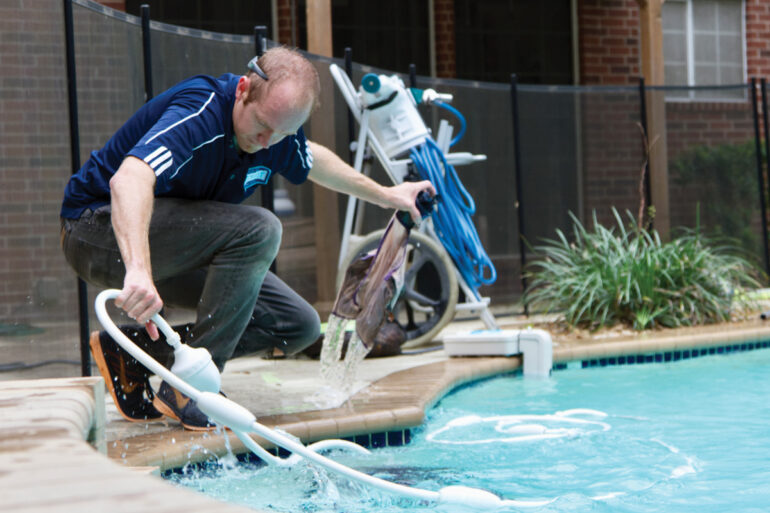Portable Power
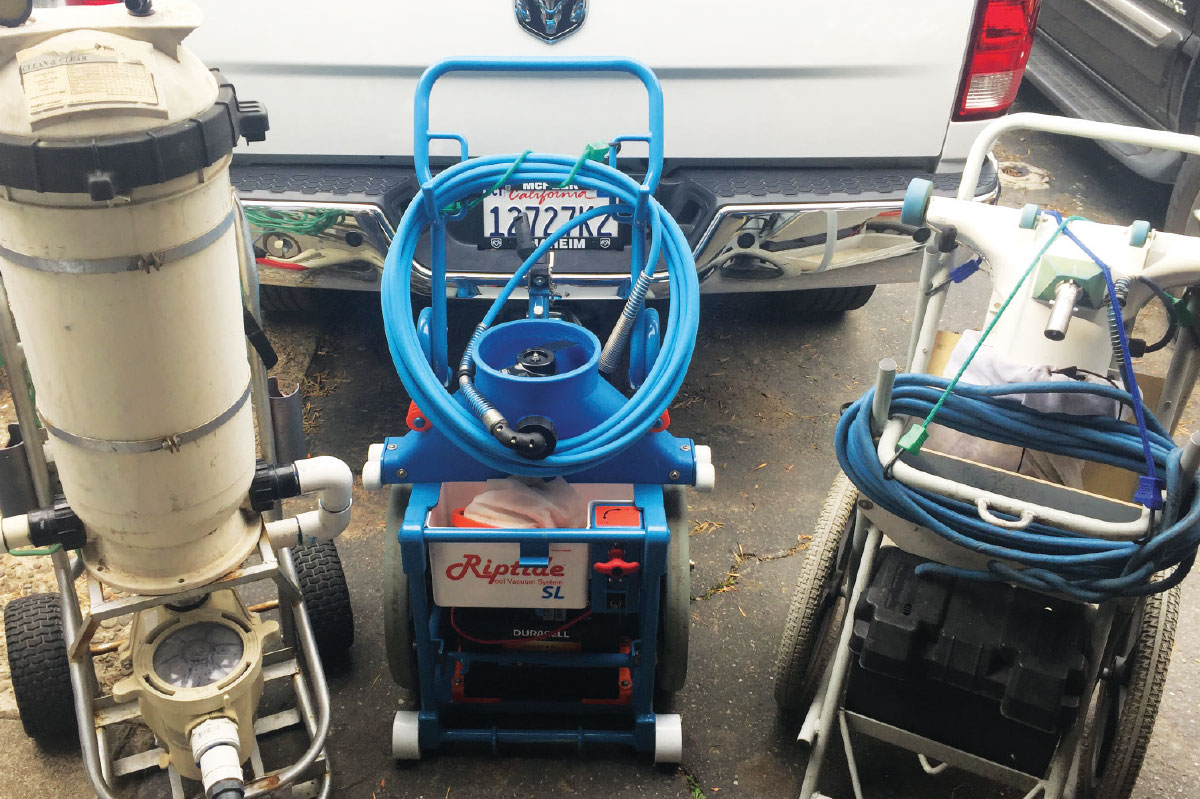
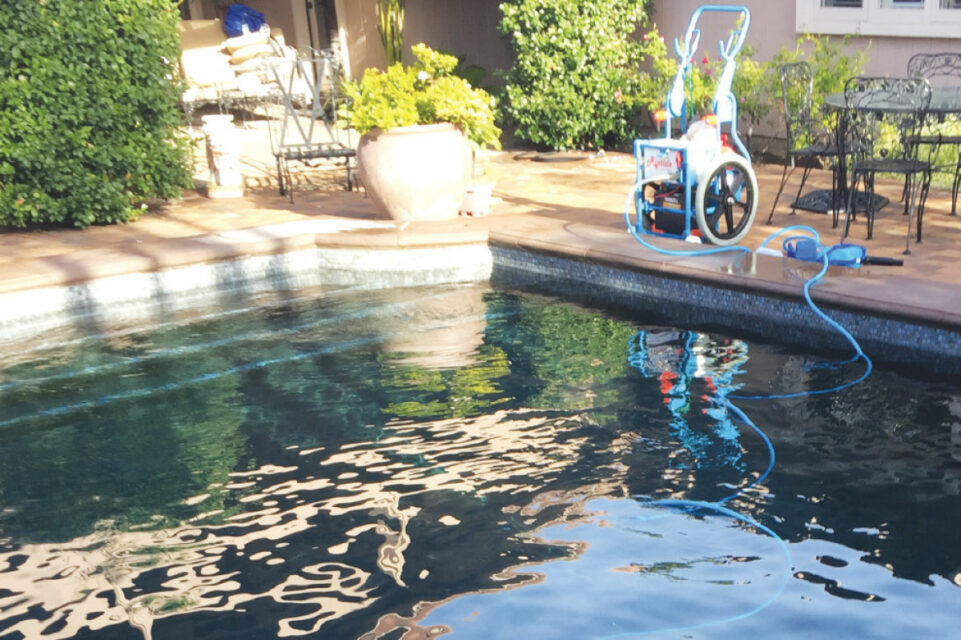
Pool pros use portable vacs to battle leaves, sand and just about everything else that can get into a pool
At least half a dozen manufacturers now make portable vacuums, and there seems to be one on every service truck. The companies that make and market them have long pushed portable vacuums as tools of necessity, not convenience. It appears pool pros have come around to that philosophy — in fact, finding a company that hasn’t invested in one proved an insurmountable challenge.
So why is a piece of equipment that was once an extra now the norm? How do pool pros use them, and how do they get the most out of them?
Which Vacuums Do Pool Pros Swear By?
If you’re searching for the perfect portable, you’ll quickly learn that you have plenty of options — but going without doesn’t seem to be one of them.
“I think it is very much worth the investment,” says Will Ives, owner of Bullfrog Pool Service in Wilmington, North Carolina. “I wish we had started incorporating them sooner.”
Ives has used a Power Vac 2100 for more than three years and also invested in a Riptide XP about a year ago.
“The general consensus of the team on preference is the Riptide,” he says. “We like that the bags never blow off the vacuum. We really like the extra suction that the bigger propeller provides. Most of us prefer the ball bearing wheel setup the Riptide has versus the swivel wheels on the Power Vac.”
Jared Keefe of California-based Keefe Pool & Spa Services uses both Hammer-Head and Riptide. He, too, tends to prefer the Riptide, although “all in all, they’re both great vacuums,” he says. “I can’t say anything bad about either of them.”
Dan Lenz, vice president of All Seasons Pools & Spas in Orland Park, Illinois, uses the Pool Blaster Pro 900 by Water Tech Corp.
“For minor cleanup, it saves time as opposed to dragging out hoses, pumps, etc.,” Lenz says. “We save at least 10 minutes per pool with a battery-powered vac.”
With more than 6,000 customers, he says those extra 10 minutes translate into better customer service: The techs can instead use that time to chat with customers and, in many cases, sell replacement parts or upgrades.
Geography Determines What You Need
Chris Morelli of South Strand Pool Maintenance in Surfside Beach, South Carolina, uses Pool Blaster Max CG (commercial grade) battery-powered pool vacs, waging a never-ending battle against the encroaching beach.
“They are terrific for getting the sand out of pools,” Morelli says. “Using this type of vac saves us time so we can get more pools cleaned faster. This is especially important to our business since most of the pools we clean are in rental homes in the summer and we clean the pools between renters. That means we can sometimes hit one pool three or four times in one week.”
He estimates Pool Blaster Max takes 20% less time to operate compared to a traditional hose vac, “which takes too much time setting up and putting away,” he says.
Sand isn’t the only natural enemy that service pros use their vacuums to battle. “I use them for really heavy leaf pickup,” Keefe says, like when the Santa Ana winds fill pools with dirt, leaves and sticks.
Ives’ region of Wilmington is also known for its bounty of trees, which for him means a whole lot of vacuuming, especially during spring and fall. “We try and optimize the routes based on pools that absolutely cannot be done without the portable vacs,” Ives says.
Ives’ conversations with fellow industry pros lead him to believe some parts of Florida and Arizona might not require an investment in a vacuum because either there isn’t much debris or pools are more likely to be protected by lanais.
Lenz, on the other hand, thinks they’re valuable in all markets, “although I would expect in Sunbelt states they may have less value, as the leaf debris would likely be less,” he says.
Morelli can’t speak for the rest of the country, but he knows from experience that a good vacuum is a must near the coast in sandy areas.
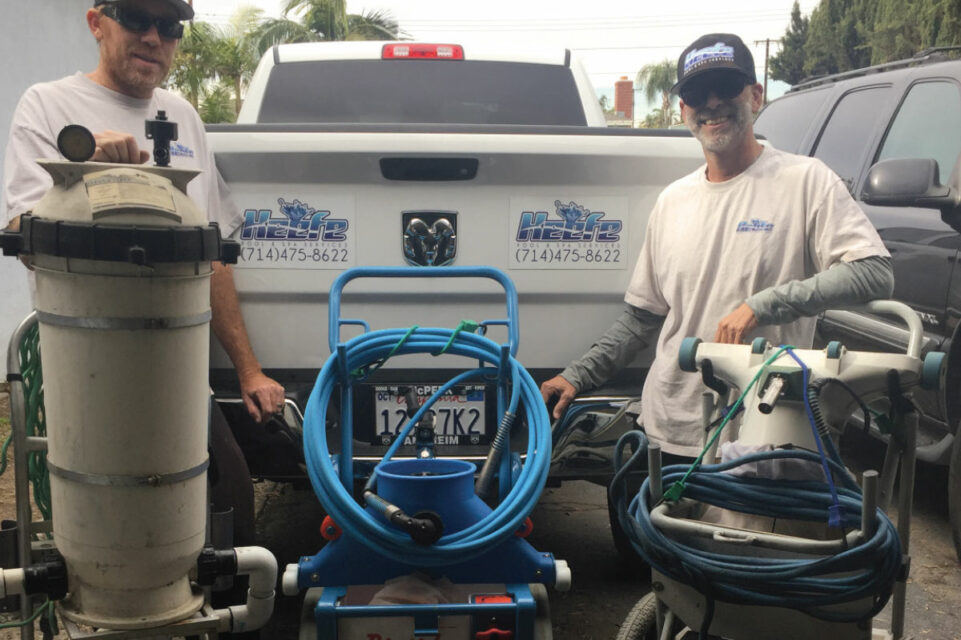
L-R: Jared Keefe and Tim Pyle, from the service side of Keefe Pool & Spa, display a T.Dula cart deck vac that Keefe reworked, along with the Riptide XL and a Hammer-Head vac.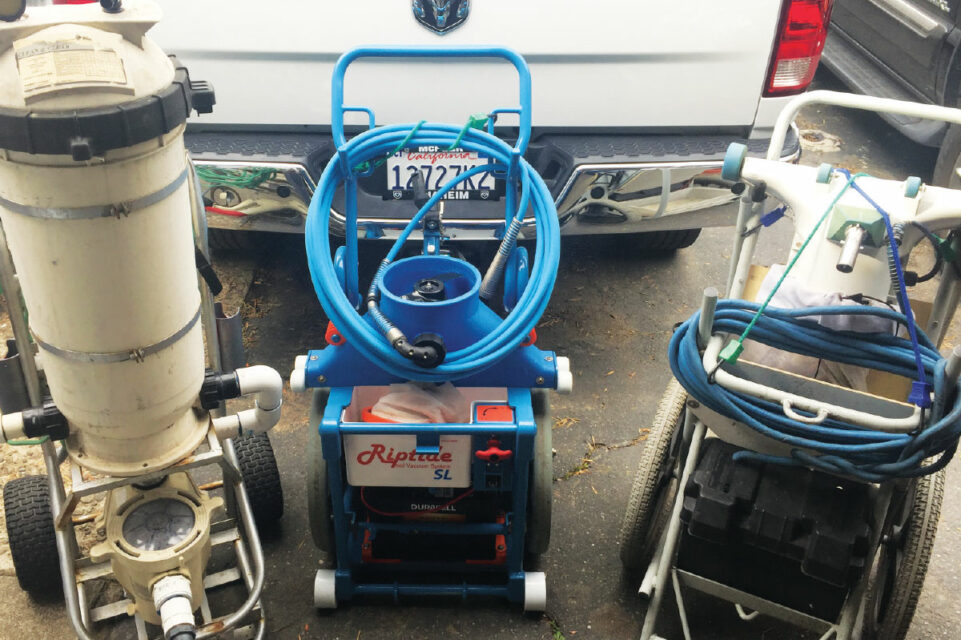
All three vacuums on display in Orange, California
Get the Most Out of Your Vac
Ives — who at one point built his own service vacuum with a variable-speed pump and cartridge filter on a dolly — urges anyone in the market for a portable vacuum to ask the following questions:
- Are you able to purchase the service cart, which increases the ease of transport from the truck to the job site?
- How much time is spent vacuuming each pool when done inline?
- How much higher are the risks of operator error when moving valves in order to vacuum inline?
For Lenz, it’s all about making sure you have enough power so your vac works at the moment of truth. “It’s important to charge them nightly and carry extra batteries,” he says. “Having the ability to charge them in the service truck helps some, too.”
Keefe, who has gotten more than a dozen years out of his Riptide, warns that just because a vacuum is durable doesn’t mean it’s built for exposure to the elements. “Do not leave it out,” he says. “Put it in the shop or put it in the garage or wherever you’re going to keep it. Keep the weather off it.”
Morelli even keeps a few portable vacuums on the shelves in his own store to sell to customers. “Many of the pools we service for renters at the beach also have pools at home,” he says. “They see us using the Pool Blaster Max and want one for their own pools.”
Advice Direct From the Manufacturer
Although the pros in the trenches offer invaluable advice, the people who make portable vacuums know a thing or two as well.
Matt Lopez of Riptide Pool Vacuums advises that the following needs to be done for proper vacuum care:
- Always unplug the power cords. Constant twisting of the cord can cause a short in the cable.
- Take care of the filter bags.
- Select the right micron bag for the right job: 60-micron bags should be used for picking up fine debris, not heavy leaf debris with sticks.
- Take care when removing the vacuum from the pool to avoid dragging the filter bag across the coping.
“Filter bags are a wear item,” Lopez says, “but we anticipate most crews should be able to get one to four months of life per bag.”
Also, accessories and attachments are often necessary — and surprisingly easy to forget to bring to the job site. “Smart service professionals should always keep all the provided components with them in their service van,” says Guy Erlich, president of Water Tech. This includes extra vac bags, vacuum heads and, in the case of Water Tech’s Pool Blaster, a second battery pack.
Matthew D’Aguanno is the inventor of The VacDaddy and the owner of Advanced Pool Technologies, LLC. He acknowledges that portable vacs, like all machines, are not without their flaws, but he believes those flaws pale in comparison to the headaches that come with built-in vacuum systems.
“That can provide challenges just as portable vacuum systems can,” D’Aguanno says. “You cannot see how the pool returns are plumbed, so using the pool system may require opening and closing of valves or plugging the intake on one or more skimmers to ensure maximum suction. Then there is the challenge of priming the hose. You may need to walk from pool to pump five or six times to adjust valves and ensure the pump is working to prime the hose. Lastly, using the pools built-in system will more quickly clog the pool’s filtration system requiring frequent cleaning or backwashing.”
Lyann Courant is the CEO of California-based Advantage Manufacturing, Inc., whose Port-a-Vac is used to clean the hippo area of the Memphis City Zoo. Like most good portables, the Port-a-Vac doesn’t require much TLC. “It’s pretty simple in terms of maintenance,” she says. “Just clean and replace the filter every so often. They should use good airtight hoses, as any air in the system will make it hard to prime the pump.”
Dean Dietrich, operations manager at Hammer-Head Patented Performance, Inc., warns against rough handling of the one accessory that’s most likely to wear out first. “The biggest wearable part will be the debris bags, and techs should treat them with care,” he says. “The other wearable parts are a lot like the ones on your car: tires, bearings, batteries and motors all wear out over time. Just like with your car, regular maintenance is the key to longevity.” From leaf-dropping trees in the Southeast to the sandy shores of California, today’s service companies rely on their vacuums as much as their trucks, and there has never been a better selection of high-quality options on the market than there is today.
Products & Specs*
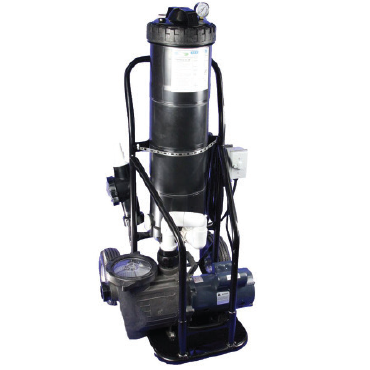
Advantage Manufacturing
Port-A-Vac: $1,499
advantageman.com
The Port-A-Vac features a pump and filter attached to a durable powder-coated steel cart. The dirty water goes into the filter cartridge and clean water is returned to the pool.
- 12-gauge, 35-foot insulated cord
- Heavy-duty tubed tires
- 150-square-foot
- cartridge filter
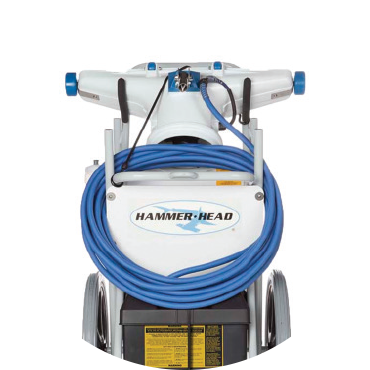
Hammer Head
Service 21: $1,715
Service 30: $1,810
hammerheadvac.com
Hammer-Head offers two classes of vacuum, Resort and Service. The Service model is designed for pool-to-pool route service and the Resort models are meant for on-site use. Service models include:
- Either 21- or 30-inch vacuum heads
- Either 40- or 60-foot power cords
- Mount assembly compatible with 2-inch hitch receivers
- 12-volt deep-cycle marine battery, battery charger
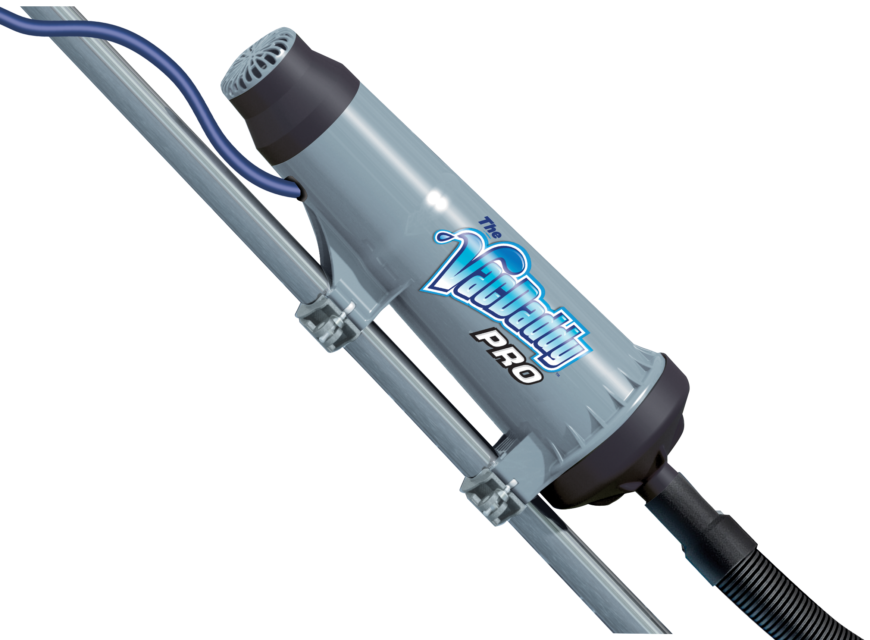
The VacDaddy
VacDaddy: $1,195
thevacdaddy.com
VacDaddy claims to make the most powerful portable vacuum on the market. At 10-12 pounds, it’s certainly light, and minimal assembly and no special training requirements make it ready to use out of the box. Features include:
- 55-60 gpm water flow
- 24V DC motor
- Reusable filter can be cleaned in two minutes

Riptide
Riptide SL: $1,700
Riptide XP: $875
riptidevac.com
Riptide offers both the XP model and the more popular SL, both of which use a 24-inch vacuum head. Features include:
- Locking bag rings that resist blowing off inside the pool
- 20-inch wheels with smooth-tread tires
- Storage bins
- Transport rack, optional license plate bracket
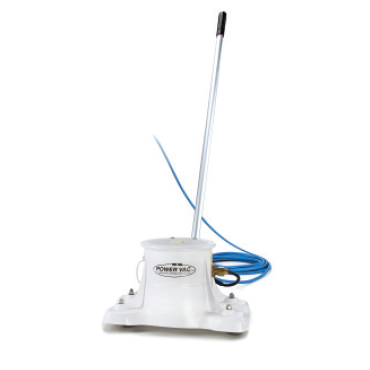
Power Vac
PV2200 Residential: $913
PV2200 Commercial: $1,201
powervaccorporation.com
Power Vac offers four options, but one is residential, one is a specialty vac designed for fountains and another is for waterparks and resorts. The Power Vac 2200, on the other hand, was built for commercial service routes. Features include:
- 8-inch throat for greater suction
- Choice of four filter bags (course, heavy duty, fine mesh and micron)
- 1.5 hours of runtime
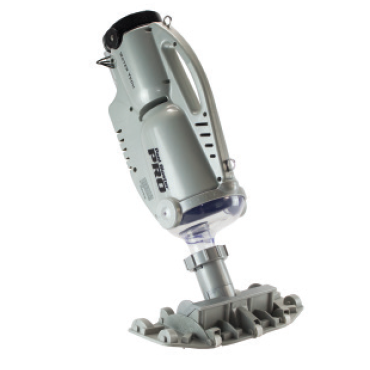
Water Tech
Water Tech Pro 900: $550
Volt FX 8-Li: $215
Pool Blaster Max Li CG: $360
watertechcorp.com
Water Tech separates itself through the sheer number of options it offers, including:
- Volt FX: The 2, 4Li and 8Li models offer different combinations of value, power
- Leaf vacs: Water Tech offers several variations of leaf vacs, including a Volt variation and several battery-powered options
*Many vacuums are sold through distribution only, so prices will vary.





